by Susan Seizer, Indiana University
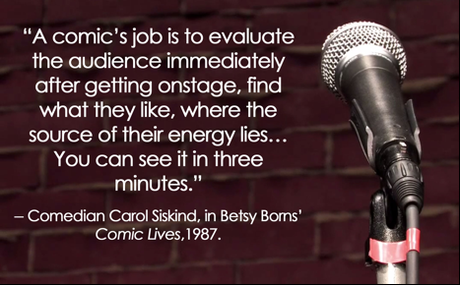
This post is about the interplay between Craft and Magic on the U.S. comedy club circuit. My interest in this topic grows out of a larger ethnographic study of the lives of Road Comics, those professional standup comedians who earn their living playing the comedy club circuit across the central states. These are not the comics you see on stages in New York or Los Angeles, or on cable shows broadcast from these two coastal media hubs. The comics I am interested in are working the road, generally playing to working class audiences and are themselves working class.
In 2012 I produced a documentary, Road Comics: Big Work on Small Stages, that follows the creativity and passion of road comics working clubs and bars in the “flyover zones” of middle America. Two of the comics featured in the film, Kristin Key and Stewart Huff, are also featured in this post. I encourage you to watch the film to see more of their performances, as well as those of another talented comedian, Tim Northern, and to experience their stories from the road as they tell them. After a lively year of festival screenings, including at the Friars Club Comedy Film Festival in New York City, the full film is now available free for streaming and downloading at www.roadcomicsmovie.com.
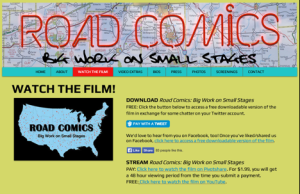
Caption: Road Comics: Big Work on Small Stages is available for streaming at www.roadcomicsmovie.com
By Craft here I mean all that such comics do to keep themselves in work: a well-crafted show not only has audiences laughing but also demonstrates to club owners and bookers that a comic can regularly make this happen. Repeat bookings depend on a comic knowing how to work a room. Craft involves all the calculations that make Magic possible; the purpose of honing one’s Craft is to have the opportunity to continue making Magic.
Magic is what happens when work works. I am particularly interested here in the many transformations a live comedy event makes possible, from how on stage comics can become someone other than themselves, to how an audience laughs here at matters too painful to confront elsewhere.
The terms Craft & Magic are tightly intertwined, and I separate them here simply to be able to point out the multiple levels on which a successful comic must think while onstage working a room. I am interested in the tension between planning and spontaneity, between the known and the unknown, between the scripted and the emergent. Craft provides the rigging on which Magic builds, and structures the structured improvisation that is live stand-up in performance.
To demonstrate my argument I’ll focus primarily on an aspect of Craft that comes into play in the first few minutes of a set: the performer’s assessment of the crowd.[1] To be successful a comic must read the crowd right. This is particularly important in road comedy, where performers work in different towns every week. Road comics have a few tricks, adding up to a set of fairly reliable tools, to help them do this. Here then is a two-and-a-half-minute clip of the successful beginning of a set into which is packed a tremendous amount of information. Here is comedian Kristin Key using the first few minutes of a 2008 show in Louisville, Kentucky, to assess the crowd and to simultaneously let them know that she is doing just that. (Note that the Emcee’s introduction is not well lit, so bear with the first minute of footage until the headliner arrives and the lights cooperate.)
What this clip shows us:
- The comedy show is marked as a structured performance event with known and named roles: “the Emcee” introduces “the Headliner.” He is well aware that he is not the draw here; he acquiesces uncomplainingly to the fact that as he performs, the stage is dark. He rushes through his little introductory story; if anyone in the audience is paying attention, he is grateful for their response.
- The localness of the event is a feature of both the narrated event and the narrating event: he tells the audience “she was driving on Pike Road last night after the show.” He assumes that this audience is local to Louisville, that they know these roads, and that they will readily see his story of a drunken
audience member crashing into a Meineke as a cautionary tale. Such assumptions turn, of course, on a prior assumption of cultural knowledge: the audience is assumed to be familiar enough with road culture in America to know that Meineke is a brake repair shop, as well as that drunk driving is illegal in the contemporary United States (and that “blowing a 2.3” means you failed dismally the drunk driving test administered by the cops).
The Emcee is charged with introducing the comic’s bonafides, thus instructing the audience in the appreciation of professional qualifications as well as in what constitutes such qualifications in a comedy club context. “A finalist on Last Comic Standing” demonstrates the umbilical cord that runs between cable television and the live club circuit, Last Comic Standing being a reality TV show broadcast on NBC in which comics compete against each other; “and a regular on The Bob & Tom Show,” refers to a more locally-based radio show that promotes regional comics (the show is produced in Indianapolis and regularly brings comics who will perform locally that weekend as guests on their show Friday mornings). In announcing these credits, the Emcee’s words set Kristin up as a comic who has both national appeal and regional experience.
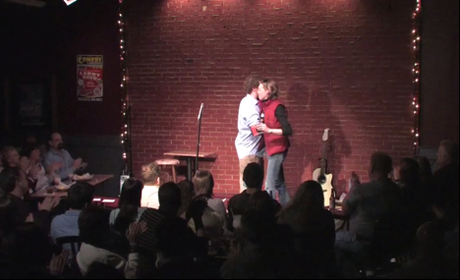
Caption: The assessment process begins with the exchange of a few whispered words, as the emcee hands the stage over to comedian Kristin Key during a 2008 show in Louisville, Ky.
- The lights go up and the music goes on. Our headliner struts onstage, beer in hand. Her every move signals casual competence. She greets the Emcee with a handshake and a hug that conveys a mutual acknowledgement of their professional status. The two comics briefly exchange a few private words. And here, unbeknownst to the crowd, begins the assessment process; comics tell me that this brief exchange most often consists of asking one question, “How drunk are they?” How drunk the audience is matters to what comics will be able to do with them; it determines what kind of show this will be, as the performer begins to assess which material in her set she can assume will work and which might go right over their heads.
- Kristin then approaches the microphone. She is upbeat, bouncy; her playful dancing expresses a lightly self-mocking attitude, jaunty, confident in her role. The first words she utters are a polite recognition of the comics who preceded her, coupled with an injunction to the audience to clap for them appreciatively. In this first address she has already taken the reins in directing the audience’s behavior and attention. Having thus established her professionalism vis–à–vis her co-workers, she now demonstrates her confidence at the mic, adjusting the stand to her stature, then removing the mic entirely and holding it in her hand.
- Kristin turns to audience and begins, “All right, Louisville; you guys have been keeping me pretty messed up all week long.” Her speech is actually a bit slurred; she is indeed a big drinker, as life meets art here in more ways than one. This gets the first audience laugh. “Uh, yesterday morning I woke up in a Meineke!” Second audience laugh, bigger than the first. Kristin has now taken on a persona: she is a woman who drinks. Her development of the “true” set-up story told by the Emcee into a seemingly spontaneous joke[2] demonstrates her competence in performance.[3] Here begins the play between scripting and spontaneity I alluded to earlier: here is the comic onstage, reacting to the same story we in the audience just heard, and she’s gone on to embellish it by embodying it. This is fun! This is someone feeling playful enough amongst us, in this very room right now, to goof around. She does a funny imitation of the imagined female drunk driver, her sloppy voice and her loose body, demonstrating how fast she herself would be able to think on her feet even while drunk… which is, in fact, what she is doing at this very moment; her performance is a classic performative speech act in the true Austinian sense.[4]
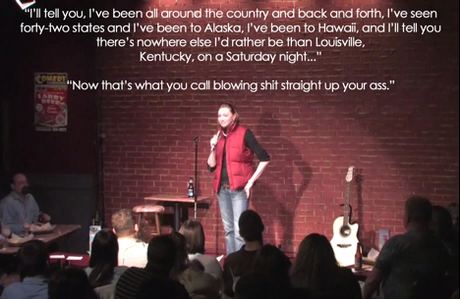
Caption: Key establishes her road comic persona during her introduction.
- Then begins the real start of Kristin’s show. I don’t know whether this is obvious to you as an audience most likely viewing her performance for the first time, but she is now beginning her scripted set, and this is her standard introduction. It doesn’t necessarily sound scripted though, does it? She continues, “Great everybody. I’ll tell you, I’ve been all around the country and back and forth, I’ve seen forty-two states and I’ve been to Alaska, I’ve been to Hawaii, and I’ll tell you there’s nowhere else I’d rather be than Louisville, Kentucky, on a Saturday night.” Third audience laugh with big, whooping, self-appreciative claps. She pauses for a deliberate beat. “Now that’s what you call blowing shit straight up your ass.” At this the fourth wave of laughter breaks and it has a different quality, like a cork popped: a woman let’s loose a peal of high-pitched laughter, and now we’re gripped. The sequence is clearly one that Kristin planned, performed, and knew would get a laugh. The topic, in addition to her practiced performance of it, serves to establish her as a seasoned road comic by enumerating what the job entails in terms of travel. But it is her cursing comic tag line that reveals her mastery as a performer: she knew she could bullshit us, names the fact that she is doing so in this casually colloquial and somewhat macho way, reveling in being our unreliable guide and letting us know she is playing us for laughs. By laughing at their own gullibility the audience cements the comic’s control of the room. (There is a good deal more to say about the many other things that her shift into using swear words and obscenity in this last joke accomplishes, but I leave that aside here and point readers instead to my essay on the uses of obscenity in live stand-up comedy recently published in Anthropological Quarterly, 2011).
- Finally we get to the overtly “audience assessment” portion of Key’s first minutes onstage. Up to this point she has made several things about herself clear, including: that she is a drinker, that she is a road comic, that she has an irreverent attitude towards the truth and that she will play us for laughs. Now she shifts her focus from defining herself to defining her audience. The process begins with the line “Nothing against your town, but everyone in this room would rather be in Hawaii now wouldn’t ya?” and continues into “We could do this shit from the beach, sipping piña coladas, smokin’ some weed,” – at which point she pauses to listen to the audience’s laughter, letting it divvy up the room for her discerning ear into pot smokers and non-pot smokers, clearly aligning herself with the former. Gesturing at the laughers she says, “Well, this section would be smokin’ some weed, everybody else would be tellin’ on us!” Letting the audience see the room from her perspective for a moment has everyone laughing at themselves, and the info she just gained allows the comic to gauge her expectations regarding this particular audience’s probable responses to particular jokes in her repertory. From here on in she will make decisions about what to perform based on this understanding. For example, she’ll decide whether or not to tell an extended anecdote about the differences between pot in California and in Texas (in this case, she chose not to). In addition to its function as an assessment tool for the comic, her public division of the room into pot smokers and non-pot smokers effects an important shift in the dynamic of the room for everyone involved. This mapping out of the sensibilities in the room allows Kristin to play the two sides of the room off each other if she so chooses; she has transformed the room into an arena where multi-voiced dialog is now possible, without, however, ceding any of her own power to orchestrate all these voices.
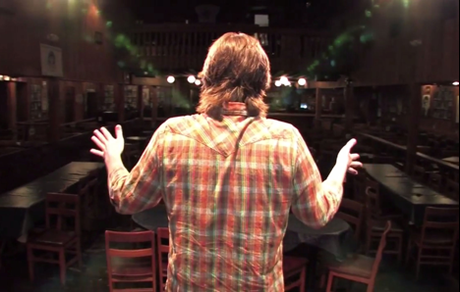
Caption: Comedian Stewart Huff on the transformative power of the stage.
It is to the subject of transformation that I now briefly turn.
I mentioned at the outset that my interest in the Craft of the stand-up comic derives from my appreciation of the larger phenomenon it makes possible, that is, the onstage Magic of good live stand-up comedy. Yet thus far I have not attended at all to what I mean by Magic, apart from noting it as the reason to bother perfecting Craft at all. Craft requires comics to raise their own antennae to assess audience receptivity. In this heightened state of attention, in the mutuality of their regard, both comic and audience are free to experience some degree of transformation. Many comics experience a liberating transformation into another, or even several other, personae onstage. Audience members too transform: often a couple arrives stressed, perhaps not speaking to each other, and leaves relaxed and holding hands (and quite possibly drunk). But whether they are drinking or not, the comedic realm they enter together affects both parties in this dance. They join in a sphere of communication marked as informal (come as you are) off-the-record (you can swear here), just-between-us (we are sharing everyday intimacies), live (here we are!) and face-to-face (I see you, this is not TV). In such a marked realm the comedian becomes our guide into an alternate, albeit temporary, world where strangers interact as intimates. Here confession, while framed as comedy, nevertheless retains some of the transformative power of redemption.
Here is Kristin on her experience of the transformative power of stand-up.
What I find striking here is Kristin’s continuing sense of awe regarding what the comedy stage makes possible for her. It still seems to surprise her, after more than a decade as a professional road comic: the feisty dom she finds in herself onstage is utterly different from the polite, friendly Southern girl she is in everyday life, who would never proudly proclaim herself as “blowing shit up your ass” – even if she were.
I’d like to add the voice of another road comic to this discussion of the transformative power of stand-up. He is Stewart Huff, another Southern comic, who is renowned for his storytelling style and his earnest generosity.
The sentiments that both Key and Huff express here are echoed in many more famous comedians’ autobiographical accounts of their experiences performing stand-up, including Dick Gregory, Steve Martin, Jerry Seinfeld, Rosanne Barr and Joan Rivers. In all these accounts there is a palpable feeling of awe at the transformations made possible by the standup stage. They turn into confident, bold, feisty figures who are utterly different from the polite and nice, or insecure and shy, people they are (or perform) in the “reality” of their everyday lives. In her onstage incarnation, Kristin Key proudly proclaims that she is “blowing shit straight up your ass,” from which moment on nobody dares mess with her. And in his transformed state as the plucky blue bird he so deeply admires, Stewart Huff, rising to the occasion of embodying our mutual liberatory potential, dances.
Susan Seizer is a cultural anthropologist in the Department of Communication and Culture at Indiana University. Road Comics: Big Work on Small Stages is the first film she has produced.
Acknowledgements: The ideas offered here were first developed in papers given in 2011, at the International Society for Humor Studies annual meetings held at Boston University in July, and then again at the American Anthropology Association annual meetings held in Montreal, Canada in November. Subsequently I have presented this material at the Invited Speakers Series, Institute of Ethnology, Academia Sinica, Taipei, Taiwan in May 2013, and to three batches of undergraduate students enrolled in an English Department class on comedy at Indiana University in 2013 and 2014. I want to thank all of the organizers and audiences at these events, and specifically Graham Jones and Gabriella Coleman, who organized the excellent AAA panel on Craft & Craftiness that served to focus my thoughts on the crafty dimensions of magic. The multi-talented Nikki Pinney has helped translate my content to this blogospheric venue, which thanks to Tracy Wuster looks so damn good.
References Cited
Austin, J. L.. 1975 [1955]. How To Do Things with Words. Second Edition. J.O. Urmson and Marina Sbisa, eds. Cambridge, MA: Harvard University Press.
Bauman, Richard. 1975. “Verbal Art as Performance.” American Anthropologist, V77 N2:290-311.
Briggs, Charles L. Competence in Performance: The Creativity of Tradition in Mexicano Verbal Art. Philadelphia: University of Pennsylvania Press.
Hariman, Robert. 2008. “Political Parody and Public Culture.” Quarterly Journal of Speech. V94 N3:247-272.
Seizer, Susan. 2011. “On the Uses of Obscenity in Live Stand-Up Comedy.” Anthropological Quarterly, V84 N1:209–234.
[1] In an insightful essay on political parody and public culture, Robert Hariman notes that audiences for stand-up are a particularly play-ready cast: “the comic quickly establishes that the audience is unruly, mixed, possibly drunk or stoned, maybe crazy, and at times also perhaps stupid, deluded, out of work, or otherwise deviant from the norms of serious, respectable, daytime routine.” Hariman’s point is that comedy co-creates a “carnivalesque spectatorship” that is based on the comic externalizing all those qualities of human bodily, and bawdy, earthiness we all share (Hariman 2008:255). I am interested in mooring this general point in the specifics of crowd assessment as it actually occurs in a live comedy show by demonstrating how the particulars of context play into a given performance.
[2] This may well have been spontaneous play, as this story told by the Emcee and the persona Kristin inhabits in response to it were not repeated in either of the other two shows performed at the club that night. I cannot vouch however for whether this sequence was repeated in any of the other shows that weekend.
[3] “Competence in performance” has been a centrally useful concept for analyzing the art of verbal performance in sociolinguistic anthropology. See Bauman 1975, and Briggs 1988.
[4] J. L. Austin, 1975 [1955].
